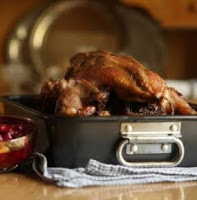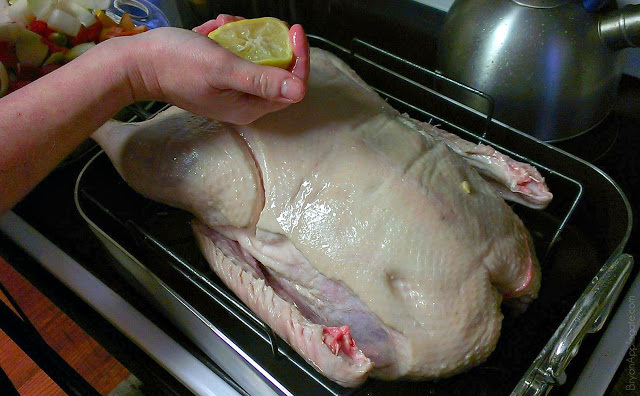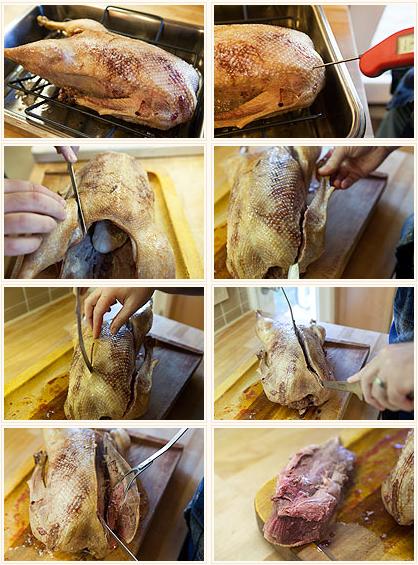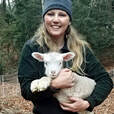
Not to fear though... this goose was soooo amazing!! It was like the very best beef filet wrapped in the juiciest bacon you've ever had. The meat was a wonderful, flavorful medium-rare and the skin was crispy with just the right amount of fat remaining to make it better than any other crispy animal fat I've ever enjoyed. If you've never had goose, you're really missing out. Here's the story of how we got that awesome beast on the table:
We start with a hunt for recipes of roasted goose perfection. There are two places that I go for absolute authoritative advice for cooking when it really counts: Christopher Kimball of America's Test Kitchen (or Cooks Illustrated/Cooks Country) and Hank Shaw of Hunter, Angler, Gardener, Cook fame. Hank will give me the in's and out's of wild food deliciousness (especially waterfowl), and Kimball will tell me exactly why it works (after testing a recipe 10 ways from Sunday). I also consulted FoodNetwork UK since Roasted Goose is still a traditional British Christmas meal.
The first thing I discovered is that you're a complete knucklehead if you cook your goose (or duck) beyond medium rare. Ducks and geese are red meat birds – meaning the breasts of both need to be served pink. I say it all the time: ducks are not chickens; so it follows that goose is not turkey.
OK... now we have more advice than we can shake a stick at and an almost 13lb free-range, all natural goose to cook for 6 people. I took everyone's expert recommendations to heart and created my own recipe (I know you saw it coming). The highlights I gleaned from the recipes were as follows:
FoodNetwork UK said to brine the goose for at least 24 hours. I went with a basic brine (1 part sea salt, 1 part brown sugar). And also followed their advice to the letter about stuffing the bird with fruit before roasting.
Kimball said that I should air-dry the goose in the refrigerator for 24 hours in order to tighten the skin so that during roasting the fat will be squeezed out. I neglected to do the boiling water dip first but I had totally intended to - I just got disorganized in the hubbub of preparing dinner.
Hank said, in his guest post at Simply Recipes, that I would better represent the Lord of the Marsh with a medium-rare breast and well roasted legs and wings. So he advises roasting the goose for a bit, then slicing off the whole breast to finish searing it in a pan once the legs are done. That way I'll still have a nice roasted flavor on the whole goose, crispy skin, and properly pink breast meat. He also has a superb photo tour for prepping the goose that I found very helpful.
We didn't take lot of pictures because we were pretty busy bustling about getting everything ready for dinner but here's the one good picture we did manage to grab:
In general, plan for:
8-10 lb goose for 5-6 people
11-12 lb goose for 6-8 people
Ingredients:
| Goose: 13 lbs free-range goose ¼ C olive oil 1 apple, quartered 1 onion, quartered 1 orange, quartered 1 lemon, halved Sea Salt | Brine: 1 C sea salt 1 C brown sugar 1 gallon water |
Prep the Goose
Thaw your goose.
Remove the neck, giblets (heart, gizzard, liver); set them aside for making gravy.
Slice off the neck skin about a half inch in front of the body; reserve for rendering.
You also need to remove excess fat from the goose. You will want to save it – goose fat is among the most delicious of all cooking fats, and it is far healthier than butter or lard: Remove the fat from inside the body cavity and put it in a bowl. Then slice off the wide belly flaps covering the body cavity; if you plan on stuffing the goose you’d need these, if not, take them off. You also want to remove the tail. All of this should go into a pot with a little water (about ½ cup) and put over low heat to render out.
Brine the Goose
In a large non-metallic container combine the sugar, salt and add one quart of boiling water, stirring to dissolve the sugar and salt completely. Add three quarts of cold water to cool the brine.
Place the goose in the brine making sure it is completely submerged. If the meat floats to the surface, weight it down with a plate. Cover and refrigerate. Allow to cure for at least 24 and up to 48 hours.
Heat large stockpot two-thirds full of water to boil.
Prick the goose's skin all over with a needle or knife tip. This will give all that fat underneath the goose’s skin somewhere to go – if you don’t, the skin will never fully crisp up. The best way to do this is to prick it with a clean needle. The technique is to stick the skin from an angle so you are not piercing the meat of the goose, just the skin. Do this all over the goose.
“Dry” the Goose
Submerge bird neck side down for 1 minute, until goose bumps arise on the skin. If your pot isn't deep enough to dunk the entire bird, turn goose tail side down, and repeat the process. Drain goose and dry thoroughly, inside and out, with paper towels.
Set goose, breast side up, on flat rack in roasting pan and refrigerate, uncovered, for 24 to 48 hours. This method tightens the skin so that during roasting the fat will be squeezed out.
After drying, remove goose from refrigerator and allow it to come to room temperature.
Cook the Goose
Put oven rack in middle position and preheat oven to 425°F.
Tuck wings across back with tips touching (photo tutorial here). This will keep them from flopping around while you’re turning the bird and crisp up the breast skin under the wing.
Rub the goose all over with the cut half of a lemon. Use both sides to get it good and coated. Put the halves inside the goose along with the rest of the quartered fruit. Sprinkle salt liberally all over the goose. Use more salt than you think you need; it helps crisp the skin and adds a lot to the flavor.
Lower the oven temp to 350°F, place the goose breast side up on a rack in a roasting pan and into the oven.
After the goose has cooked for 20 minutes pour out the goose fat that's collecting in the bottom of the roasting pan. Put it in the pre-warmed mason jar to save (I got over a quart from my goose!). If you’re making roasted vegetables, now is the time to coat them with some goose fat and put them in the oven to roast.
When you’re done, put the goose back into the oven for another 25 minutes. When a total of 45 minutes of cooking time has elapsed, test the temperature of the breast. You should have something between 130 and 140 degrees. If you’re there, remove the goose but keep the oven on.
Carve out the breasts
Now you need to carve off the whole breasts.
Put the goose (minus the breasts) back into the oven. Let this cook for another 45 minutes to finish the rest of the goose
After the additional 45 minutes are up, probe the thickest part of the goose’s thigh with a thermometer. You want 165-175 degrees. If it is a little low or high, that’s fine. Remove the goose.
Check the root veggies, and if they are done, great. If not, keep them in the oven for the moment.
Sear the breasts
Now get a large sauté pan hot. Add some goose fat, and let that get hot over medium-high heat.
Take the goose breasts, which should be a lovely pink on the meat side, and pat them dry. Place them skin side down (don’t cook them on the meat side!) in the pan and sear the skin hard. You might need to press down on them a little to get good contact. Check after 3-4 minutes. You want a rich brown.
When it is ready, remove the breasts and immediately salt the skin. Set aside, skin side up.
Carve the Goose
Here’s a pretty good video:
Serve and enjoy!
Oh, yeah... and save that wonderful goose fat! That stuff is so much healthier for you to cook with than any processed fat around. It's also the absolute BEST for roasting potatoes (or anything for that matter). Put it in your fridge and it'll keep for ages.




 RSS Feed
RSS Feed



